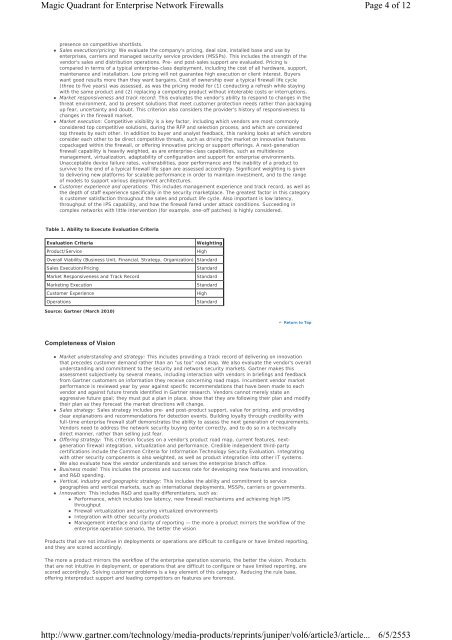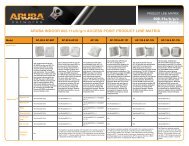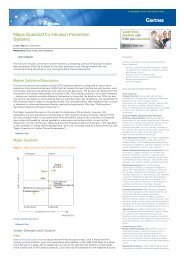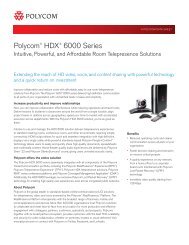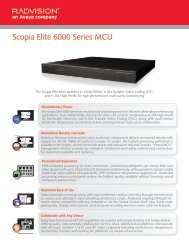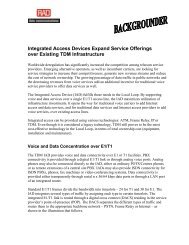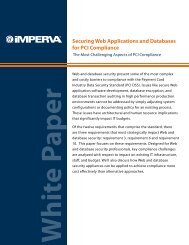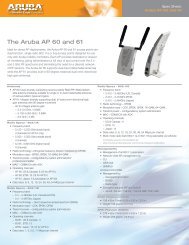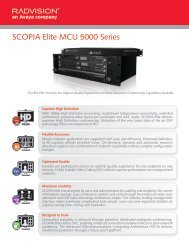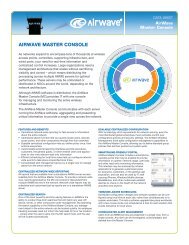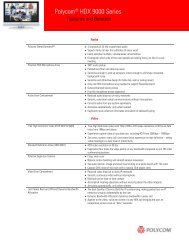Magic Quadrant for Enterprise Network Firewalls.pdf - WIT
Magic Quadrant for Enterprise Network Firewalls.pdf - WIT
Magic Quadrant for Enterprise Network Firewalls.pdf - WIT
You also want an ePaper? Increase the reach of your titles
YUMPU automatically turns print PDFs into web optimized ePapers that Google loves.
<strong>Magic</strong> <strong>Quadrant</strong> <strong>for</strong> <strong>Enterprise</strong> <strong>Network</strong> <strong>Firewalls</strong><br />
http://www.gartner.com/technology/media-products/reprints/juniper/vol6/article3/article...<br />
Page 4 of 12<br />
6/5/2553<br />
presence on competitive shortlists.<br />
• Sales execution/pricing: We evaluate the company's pricing, deal size, installed base and use by<br />
enterprises, carriers and managed security service providers (MSSPs). This includes the strength of the<br />
vendor's sales and distribution operations. Pre- and post-sales support are evaluated. Pricing is<br />
compared in terms of a typical enterprise-class deployment, including the cost of all hardware, support,<br />
maintenance and installation. Low pricing will not guarantee high execution or client interest. Buyers<br />
want good results more than they want bargains. Cost of ownership over a typical firewall life cycle<br />
(three to five years) was assessed, as was the pricing model <strong>for</strong> (1) conducting a refresh while staying<br />
with the same product and (2) replacing a competing product without intolerable costs or interruptions.<br />
• Market responsiveness and track record: This evaluates the vendor's ability to respond to changes in the<br />
threat environment, and to present solutions that meet customer protection needs rather than packaging<br />
up fear, uncertainty and doubt. This criterion also considers the provider's history of responsiveness to<br />
changes in the firewall market.<br />
• Market execution: Competitive visibility is a key factor, including which vendors are most commonly<br />
considered top competitive solutions, during the RFP and selection process, and which are considered<br />
top threats by each other. In addition to buyer and analyst feedback, this ranking looks at which vendors<br />
consider each other to be direct competitive threats, such as driving the market on innovative features<br />
copackaged within the firewall, or offering innovative pricing or support offerings. A next-generation<br />
firewall capability is heavily weighted, as are enterprise-class capabilities, such as multidevice<br />
management, virtualization, adaptability of configuration and support <strong>for</strong> enterprise environments.<br />
Unacceptable device failure rates, vulnerabilities, poor per<strong>for</strong>mance and the inability of a product to<br />
survive to the end of a typical firewall life span are assessed accordingly. Significant weighting is given<br />
to delivering new plat<strong>for</strong>ms <strong>for</strong> scalable per<strong>for</strong>mance in order to maintain investment, and to the range<br />
of models to support various deployment architectures.<br />
• Customer experience and operations: This includes management experience and track record, as well as<br />
the depth of staff experience specifically in the security marketplace. The greatest factor in this category<br />
is customer satisfaction throughout the sales and product life cycle. Also important is low latency,<br />
throughput of the IPS capability, and how the firewall fared under attack conditions. Succeeding in<br />
complex networks with little intervention (<strong>for</strong> example, one-off patches) is highly considered.<br />
Table 1. Ability to Execute Evaluation Criteria<br />
Evaluation Criteria<br />
Weighting<br />
Product/Service<br />
High<br />
Overall Viability (Business Unit, Financial, Strategy, Organization) Standard<br />
Sales Execution/Pricing<br />
Standard<br />
Market Responsiveness and Track Record<br />
Standard<br />
Marketing Execution<br />
Standard<br />
Customer Experience<br />
High<br />
Operations<br />
Standard<br />
Source: Gartner (March 2010)<br />
Return to Top<br />
Completeness of Vision<br />
• Market understanding and strategy: This includes providing a track record of delivering on innovation<br />
that precedes customer demand rather than an "us too" road map. We also evaluate the vendor's overall<br />
understanding and commitment to the security and network security markets. Gartner makes this<br />
assessment subjectively by several means, including interaction with vendors in briefings and feedback<br />
from Gartner customers on in<strong>for</strong>mation they receive concerning road maps. Incumbent vendor market<br />
per<strong>for</strong>mance is reviewed year by year against specific recommendations that have been made to each<br />
vendor and against future trends identified in Gartner research. Vendors cannot merely state an<br />
aggressive future goal; they must put a plan in place, show that they are following their plan and modify<br />
their plan as they <strong>for</strong>ecast the market directions will change.<br />
• Sales strategy: Sales strategy includes pre- and post-product support, value <strong>for</strong> pricing, and providing<br />
clear explanations and recommendations <strong>for</strong> detection events. Building loyalty through credibility with<br />
full-time enterprise firewall staff demonstrates the ability to assess the next generation of requirements.<br />
Vendors need to address the network security buying center correctly, and to do so in a technically<br />
direct manner, rather than selling just fear.<br />
• Offering strategy: This criterion focuses on a vendor's product road map, current features, nextgeneration<br />
firewall integration, virtualization and per<strong>for</strong>mance. Credible independent third-party<br />
certifications include the Common Criteria <strong>for</strong> In<strong>for</strong>mation Technology Security Evaluation. Integrating<br />
with other security components is also weighted, as well as product integration into other IT systems.<br />
We also evaluate how the vendor understands and serves the enterprise branch office.<br />
• Business model: This includes the process and success rate <strong>for</strong> developing new features and innovation,<br />
and R&D spending.<br />
• Vertical, industry and geographic strategy: This includes the ability and commitment to service<br />
geographies and vertical markets, such as international deployments, MSSPs, carriers or governments.<br />
• Innovation: This includes R&D and quality differentiators, such as:<br />
• Per<strong>for</strong>mance, which includes low latency, new firewall mechanisms and achieving high IPS<br />
throughput<br />
• Firewall virtualization and securing virtualized environments<br />
• Integration with other security products<br />
• Management interface and clarity of reporting — the more a product mirrors the workflow of the<br />
enterprise operation scenario, the better the vision<br />
Products that are not intuitive in deployments or operations are difficult to configure or have limited reporting,<br />
and they are scored accordingly.<br />
The more a product mirrors the workflow of the enterprise operation scenario, the better the vision. Products<br />
that are not intuitive in deployment, or operations that are difficult to configure or have limited reporting, are<br />
scored accordingly. Solving customer problems is a key element of this category. Reducing the rule base,<br />
offering interproduct support and leading competitors on features are <strong>for</strong>emost.


